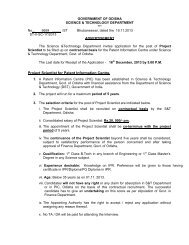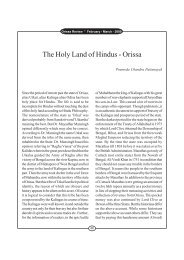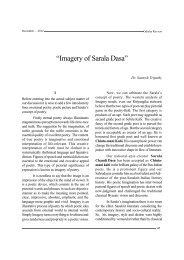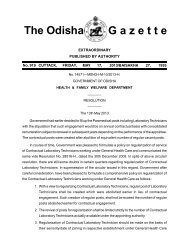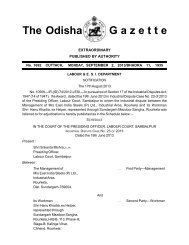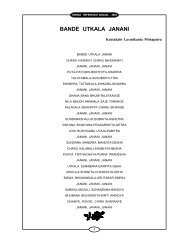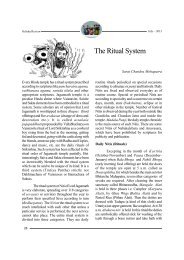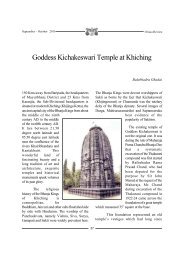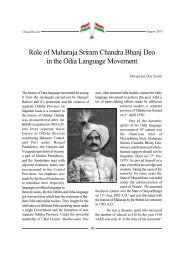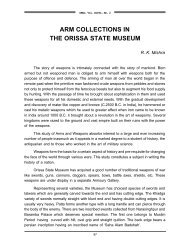Puja Rituals in Srimandir
Puja Rituals in Srimandir
Puja Rituals in Srimandir
You also want an ePaper? Increase the reach of your titles
YUMPU automatically turns print PDFs into web optimized ePapers that Google loves.
Shri Jagannath <strong>in</strong> Yantra, Tantra and Mantra<br />
The mode of worship of Sri Jagannath is<br />
unique and different from that of the other Vishnu<br />
temples, situated <strong>in</strong> north and south India. Sri<br />
Jagannath is Pranab; He has been identified with<br />
the mystic Vedic Bijamantra 'Om'. His puja has<br />
been developed and systematized <strong>in</strong> a well<br />
designed- process by coord<strong>in</strong>at<strong>in</strong>g the basics of<br />
Vedic, Tantric and Vaisnavite streams.<br />
Dharmashastras prescribe three ma<strong>in</strong> streams for<br />
the puja of H<strong>in</strong>du Devatas, those are - Nigam,<br />
Agam and Lokacar. Nigam is the pure Vedic<br />
system, Agam is the tantric system and Lokacar<br />
is the comb<strong>in</strong>ation of both or some other system,<br />
which is followed with reference to the prevail<strong>in</strong>g<br />
conditions of the locality, time and authorities.<br />
Nigam - (the Vedic system) - The guide<br />
for Vedic Upasana (Nigam) is Karmakanda;<br />
which concentrates ma<strong>in</strong>ly on Japa, Jaga and<br />
Yagnya (fire sacrifice). - 'Swatah<br />
pramanswarup Veden nischitartho nigamyate<br />
gnayeta iti atah Vedah Nigamah, Nigamyate<br />
gnayete anena iti Nigamah.'(Devi Bhagavat -<br />
1-5-61)<br />
Agam (Tantra) - Agam or Tantra Sastra is<br />
very much elaborate and conta<strong>in</strong>s the multiple<br />
system of Upasana. The proper mean<strong>in</strong>g of the<br />
term Agam is that which has come out of the<br />
Orissa Review June - 2009<br />
<strong>Puja</strong> <strong>Rituals</strong> <strong>in</strong> <strong>Srimandir</strong><br />
15<br />
Padmanabha Mahapatra<br />
mouth of Siva; that which has entered <strong>in</strong>to the<br />
mouth of Uma; and that which is the op<strong>in</strong>ion of<br />
Vishnu. - 'Agatam Sivamukhabjat gatam tu<br />
Girija mukhe, matam ch Basudevasya tasmat<br />
Agama uchyate'. So Agam or Tantra Sastra is<br />
ma<strong>in</strong>ly based on three aspects, such as - Saivism;<br />
(Saivagam) Saktism (Saktagam) and Vaishnavism<br />
(Vaishnavagam). Agam or Tantra Sastra is a<br />
means for over all development of human society<br />
- 'Dharmarth kamamokhyadi chaturbarga<br />
sadhan pathpradarshak.'<br />
'Tantra aims to transform every action <strong>in</strong><br />
life <strong>in</strong>to a ritual, so that the <strong>in</strong>dividual performs<br />
every action and thought with a feel<strong>in</strong>g of worship<br />
and awareness. The action of bath<strong>in</strong>g, dress<strong>in</strong>g,<br />
sitt<strong>in</strong>g for worship, offer<strong>in</strong>g various symbolic<br />
sacrifices, sexual relations, stages of development<br />
from <strong>in</strong>ception to womb, birth to marriage etc.<br />
are transformed <strong>in</strong>to worship. The aim of Tantra<br />
is to unleash the cosmic energy <strong>in</strong> man, so that he<br />
rises to higher level of awareness.' ('A systematic<br />
course <strong>in</strong> ancient Tantric Techniques of Yoga and<br />
Kriya' - Swami Satyananda Saraswati-P.P. - 335<br />
/336)<br />
Tantra has been divided <strong>in</strong>to 64 parts -<br />
'Chatuhsasthi ch Tantrani'. Over and above<br />
that, sa<strong>in</strong>ts such as Kapila, Jaim<strong>in</strong>i, Basistha,<br />
Pulastya, Bhrugu, Yagnyabalkya, Sukra and<br />
Brihaspati etc. have written huge number of
Upaantras also. Tantric system has some Acaras;<br />
out of them Bamacara and Kaulacara are most<br />
important. Bamacara is not suitable for<br />
Vaishnavite system. In Tantra, Yantra and Mantra<br />
play the major role.<br />
Yantra - Yantra is the body of the deity.<br />
<strong>Puja</strong> of a deity is required to be taken up on a<br />
Yantra, so Yantra is very important.<br />
'Sarbeshameb Devanam Yantrapuja<br />
Prasashyate' (Gautami Tantra). Without a Yantra,<br />
<strong>Puja</strong> can not be taken up. If the Yantra is not<br />
known then eight-petalled lotus is to be accepted<br />
as Yantra and the puja is to be undertaken<br />
accord<strong>in</strong>gly. 'B<strong>in</strong>a Yantren chet puja Devata<br />
na prasidati, Anuktakalpe Yantram tu likhet<br />
Padmadalastakam '. (Gautami Tantra)<br />
Mantra - Mantra is the soul of the deity<br />
on a Yantra. - 'Mantrayate guptam paribhasate<br />
iti Mantrah'. Mantra is secrete, to be learnt from<br />
the best Guru. The sound of the Mantras be<strong>in</strong>g<br />
chanted comb<strong>in</strong>ed with the power of the resolve<br />
made by the person perform<strong>in</strong>g the <strong>Puja</strong>, reaches<br />
the div<strong>in</strong>e power that converts the chants <strong>in</strong>to the<br />
desired bless<strong>in</strong>gs. It is a must that Mantras are<br />
very powerful. But they must be chanted <strong>in</strong> a<br />
balanced note and rhythm. - 'Manah<br />
santoshanam saucham maunam mantrarth<br />
ch<strong>in</strong>tanam, Abyagramanirbedah japamsapatti<br />
hetabah'.<br />
Mantras <strong>in</strong> a gross level are special sound<br />
patterns. On a deeper sense they are still much<br />
more. Along with Mandalas and Yantras, Mantras<br />
are most important and considered as the essence<br />
of the practical Tantra. Mantras and Yantras<br />
(Mandalas) are utilized <strong>in</strong> conjunction with each<br />
other to form powerful comb<strong>in</strong>ation. A Mandala,<br />
Yantra or Devata is the form of consciousness.<br />
The Mandalas, Yantras or Devatas are the<br />
manifested forms, configurations of Shakti, while<br />
the Mantra, which is also Shakti, is the l<strong>in</strong>k<br />
Orissa Review June - 2009<br />
16<br />
between consciousness and form. This system<br />
applies to every th<strong>in</strong>g <strong>in</strong> the world around us. The<br />
visible form is the expression, while the Mantra is<br />
the vehicle of expression. Mantra is the direct l<strong>in</strong>k<br />
with the beyond.<br />
The deities on the Simhasana of <strong>Srimandir</strong>a<br />
have been placed on specific Yantras; Sri<br />
Balabhadra on Tara Yantra, Sri Subhadra on<br />
Bhubaneswari Yantra and Sri Jagannatha on Kali<br />
Yantra. The Daru Devatas (made of wood)<br />
themselves are Tantrics, because their<br />
construction has been made on Tantric<br />
background, with reference to Matsya Purana,<br />
Sanatkumar Samhita, Biswamitra Samhita and<br />
Hayasirsha Samhita etc., all Tantric Texts. The<br />
Vimana of Sri Mandir is a Siddha Pitha and the<br />
deities are the SiddhaYantras. To keep the<br />
Yantras; eng<strong>in</strong>es mov<strong>in</strong>g; the presence of a<br />
perfectly tra<strong>in</strong>ed and experienced Yantree or<br />
Eng<strong>in</strong>eer is always required; he is the <strong>Puja</strong>k <strong>in</strong> the<br />
literature of Sri Mandira and he is charged on<br />
Tantra. 'Mananatt Mantrah' Mantra is very<br />
difficult; it can only be learnt from perfect Gurus<br />
or teachers; and it is the only means to take up<br />
<strong>Puja</strong> <strong>in</strong> a systematic manner. Who are the Gurus<br />
then ? They are Brahma, Vishnu and Maheswar.<br />
From the above analogy we conclude that <strong>in</strong> the<br />
<strong>Puja</strong> Paddhati of <strong>Srimandir</strong>a, Guru is there <strong>in</strong> place<br />
of Mantra; <strong>Puja</strong>k is there <strong>in</strong> place of Tantra and<br />
the deities are there <strong>in</strong> place of Yantras.<br />
System of Pancaratram <strong>Puja</strong>paddhati<br />
Narada Purana mentions that the <strong>Puja</strong> of<br />
Sri Purusottama was be<strong>in</strong>g undertaken accord<strong>in</strong>g<br />
to the tenets of Pancaratra system dur<strong>in</strong>g the time<br />
of k<strong>in</strong>g Indradyumna. The same system with some<br />
additions and alterations cont<strong>in</strong>ues even at present.<br />
Among the different discipl<strong>in</strong>es of Vaishnava<br />
worship the system of Pancaratram holds a very<br />
prom<strong>in</strong>ent position. The Supreme Narayana<br />
himself, who <strong>in</strong> turn taught it to Uddhab with<strong>in</strong>
the span of five nights, directly imparted it to Sage<br />
Narad. Pancaratram literature glorifies image<br />
worship as even superior to the Vedas. Whatever<br />
that may be, under this system, the idols have been<br />
held as very necessary to conceive and meditate<br />
on God.<br />
Texts on <strong>Puja</strong>paddhati<br />
Some ritual texts exhibit<strong>in</strong>g the mode of<br />
worship of Jagannath, as available at present are<br />
mentioned below.<br />
Gajapati Purusottama Dev (1466-1497<br />
A.D), the famous Gajapati k<strong>in</strong>g of Ganga dynasty,<br />
compiled 'Gopalarchanavidhi' on the rites and<br />
rituals of Sri Jagannatha and 'Muktich<strong>in</strong>tamani' on<br />
the sanctity of Purusottama Puri. Gopalarchanavidhi<br />
otherwise known as 'Niladr<strong>in</strong>atha<br />
<strong>Puja</strong>vidhi' and 'Niladrimahodayarcanavidhi' have<br />
been compiled on the Vaishnava Skandha of<br />
Agamakalpataru.<br />
Narasimha Mishra Vajpeyee (1525-1580<br />
A.D) was the famous Smrti writer and royal<br />
preceptor of Gajapati Prataparudra Dev (1497-<br />
1533AD). Out of his 18 volum<strong>in</strong>ous works<br />
'Nityacarapradeepa' was the best and it has been<br />
published by the Asiatic Society of Bengal <strong>in</strong><br />
1928. Nityacarapradeepa has been divided <strong>in</strong>to<br />
4 parts exclud<strong>in</strong>g its Parivasa Prakaran. In this<br />
work the author described <strong>in</strong> detail, about all the<br />
temples, tirthas, lakes, Gods and Goddesses of<br />
Srikhetra. There<strong>in</strong> he has suggested for<br />
worshipp<strong>in</strong>g Sri Balabhadra <strong>in</strong> Sankarshana<br />
mantra, Sri Jagannatha <strong>in</strong> Krishna mantra and<br />
Goddess Subhadra <strong>in</strong> Devi mantra.<br />
Gadadhar Rajguru Mahapatra (1700-<br />
1750 AD) was a reputed Smrti writer, his<br />
compiled work 'Gadadharpaddhiti' has also been<br />
published by the Asiatic society <strong>in</strong> 1904 and<br />
1908. In his 'Kalasar,' <strong>in</strong> the Mangalacaran he<br />
has started with pray<strong>in</strong>g Lord Jagannath and<br />
mother Vimala. Sri Gautamiya Tantra is another<br />
Orissa Review June - 2009<br />
17<br />
work, stated to have been orig<strong>in</strong>ated at<br />
Purusottam Khetra; it has also much <strong>in</strong>fluence on<br />
the puja system of Sri Jagannath.<br />
Niladri Mahodaya is a very popular work.<br />
It states the orig<strong>in</strong>, rites and rituals of Sri<br />
Jagannath. But the period of its compilation and<br />
about it's actual author are not yet def<strong>in</strong>ite. Some<br />
say that it was compiled at the time of Ganga k<strong>in</strong>g<br />
Bhanudev IV (1414-1435 AD), but this book as<br />
a reference is not found to have been quoted by<br />
any author of Orissa till 18th century. So it comes<br />
to one's m<strong>in</strong>d that it is a later compilation. Niladri<br />
Mahodaya conta<strong>in</strong>s 91 chapters, deal<strong>in</strong>g <strong>in</strong> detail<br />
with all the rites and rituals and day-to-day<br />
functions <strong>in</strong> Jagannath temple. It is a compilation<br />
based on all Dharmasastras, Puranas and Tantras<br />
etc., hence it is called as 'Sthala Purana' <strong>in</strong> Orissa.<br />
However, the latest compilation of Niladri<br />
Mahodaya along with its Oriya translation has<br />
been edited by Dr B.K Swa<strong>in</strong> and published by<br />
Sadgrantha Niketan, Puri recently <strong>in</strong> two volumes<br />
and available <strong>in</strong> the market.<br />
Over and above all references cited above,<br />
the fairs and festivals, rites and rituals of Sri<br />
Jagannath Temple have been discussed <strong>in</strong> the<br />
follow<strong>in</strong>g works.<br />
(a) Gopalarchanapaddhati by Sri Basudev<br />
Tripathy (1700- 1750 AD).<br />
(b) Kalanirnaya - by Sri Raghunath Das (1715-<br />
1750 AD)<br />
(c) Kalsarvasva - by Sri Krishna Mishra (1750<br />
AD)<br />
(d) Virasarvasva - by Sri Gop<strong>in</strong>ath Tripathy<br />
(1778 AD)<br />
(e) Bamdev Samhita - Published by<br />
Muktimandap Pandit Sava, Puri dur<strong>in</strong>g<br />
1972.<br />
(f) Surisarvasva - by - Gov<strong>in</strong>da Kabibhusana<br />
Samantaray; edited by Sri Bhagaban Panda
and published by Orissa State Museum<br />
(published <strong>in</strong> 2 parts <strong>in</strong> 1974 and 1994)<br />
All such texts except 'Surisarvasva' have<br />
broadly dealt with the puja systems of Sri<br />
Jagannath only, but there are no ancient<br />
<strong>in</strong>dependent ritual texts exhibit<strong>in</strong>g the detailed<br />
mode of worship of Sri Balabhadra and<br />
Subhadra. Even though there are some<br />
<strong>in</strong>dependent temples of Balabhadra / Baladev <strong>in</strong><br />
some places of Orissa, which are of later orig<strong>in</strong>,<br />
the <strong>Puja</strong>ks thereof state that they follow the similar<br />
mode of worship to that of Puri temple. One small<br />
text 'Surisarvasvokta Sri Basudev <strong>Puja</strong>paddhatih'<br />
compiled by Pandit Sri Jameswara Mishra<br />
Sharma around fifty years back exhibit the puja<br />
system of only Sri Balabhadra.<br />
The Tantric texts of other states of India,<br />
which have much similarity with the puja system<br />
of Sri Jagannath, are 'Saradatilak' and<br />
'Karmadipika'. Saradatilak of Laxman Desika<br />
seems to be a composition of middle of the 10th<br />
century. The mode of worship of Srikrishna-<br />
Trailokyamohan, recommended <strong>in</strong> this work has<br />
much similarity with the worship of Purusottama<br />
Jagannath and it is compatibility to the religious<br />
notions of Orissa. 'Karmadipika' of Kesava Bhatt<br />
Kashmirika, a follower of Nimbarka School of<br />
Visnuism, is a composition of 14th century. This<br />
text is more authoritative on the worship of Gopal<br />
Krishna with the eighteen-syllabic and ten-syllabic<br />
Mantras. It does not accept Radha as the consort<br />
of Krishna but considers Rukm<strong>in</strong>i and<br />
Satyabhama as His legitimate wives. The <strong>in</strong>fluence<br />
of 'Karmadipika' on the <strong>Puja</strong> system of Jagannath<br />
is much more than any other text.<br />
In the entire Pancaratra there is only one<br />
text i.e. 'Parasara Samhita' that mentions about<br />
Sri Jagannath of Purusottam Khetra. As <strong>in</strong> the<br />
'Jagannath Khetramahatmya' of 'Skanda Puran',<br />
Orissa Review June - 2009<br />
18<br />
the Parasara Samhita quotes the <strong>in</strong>tegrated form<br />
of Lord Jagannath, Balabhadra and Subhadra. -<br />
'Jagannatheti bamangam<br />
Balaramardharup<strong>in</strong>am / Subhadrakhya-<br />
Mahalaxmi rupasardhangabesh<strong>in</strong>am // xxxx<br />
Tam paraparamabyaktam namami<br />
Purusottamam '.// Here Goddess Subhadra has<br />
been accepted as Goddess Laxmi, who blesses<br />
the world with auspicious boons.<br />
Feel<strong>in</strong>g of a common man -<br />
When a normal devotee hears the puja<br />
proceed<strong>in</strong>gs <strong>in</strong> Jagannath temple, he feels that the<br />
puja mantras are partly Vedic, partly Tantric and<br />
partly Puranic. The Vedic part is the use of 'Om',<br />
at the <strong>in</strong>itiation of the puja -mantra; the Tantric<br />
part is the use of 'Klim' for Jagannath - 'Hrim' for<br />
Subhadra, 'Slim' for Balabhadra after utterance<br />
of 'Om'. The Puranic part is - Krishna - Jagannath,<br />
Basudev - Balabhadra, Bhubaneswari -<br />
Subhadra. Sudarshan is formless, Turiya (gap<br />
between two recitation of Om), He is considered<br />
as 'Jyotibrahma'.<br />
System of worship followed at present -<br />
The seriatim of puja (<strong>Puja</strong>krama) is almost<br />
equal <strong>in</strong> respect of all the major deities placed on<br />
the Ratnasimhasan. Only we f<strong>in</strong>d variation <strong>in</strong> the<br />
Mulamantra, Devata Nyasa, Pitha Nyasa, Mantra<br />
Nyas and Murtipanjar Nyas mantras <strong>in</strong> respect of<br />
each of them, those are exhibited <strong>in</strong> the follow<strong>in</strong>g<br />
chart. As regards the Avarans (Associates) of each<br />
deity, the factual position has been expla<strong>in</strong>ed just<br />
below the chart worked out. So far as the Bhuta<br />
Suddhi, Pranab; Pran Pratistha, Martka Nyasa are<br />
concerned, the basic mantras are the guidel<strong>in</strong>es.<br />
The Upacara puja <strong>in</strong>cludes 16 Upacaras start<strong>in</strong>g<br />
from Asana to Vandana as exhibited <strong>in</strong> the<br />
succeed<strong>in</strong>g paragraphs. Dhyan mantras of all the<br />
four deities are <strong>in</strong>corporated <strong>in</strong> the last paragraph<br />
of this article.
Orissa Review June - 2009<br />
Balabhadra Subhadra Jagannath<br />
References Basudev <strong>Puja</strong> Paddhati Bhubaneswari <strong>Puja</strong> Gopalarchana <strong>Puja</strong><br />
Paddhati Paddhati<br />
Mantra Dwadasakhyar Basudev Ekakhyari Bhubaneswari Astadasakhyar<br />
Mantra Mantra Gopal Mantra<br />
'Om Namo Bhagabate "Hrim'' 'Om Klim Krishnaya<br />
Vasudevaya' Gov<strong>in</strong>daya Gopijan<br />
Ballavaya'<br />
Devata Nyasa Srikanthadi Nyasa Kala Nyasa Keshavadi Nyasa<br />
Pitha Nyasa -do - - do - - do -<br />
Mantra Nyasa Basudev Mantra Bhubaneswari Mantra Gopal Mantra<br />
Murtipanjar Nyasa - do - - do - - do -<br />
Bibhuti Panjar Nyasa<br />
As regards Sri Sudarshan there is a specific<br />
mantra, He is referred to as a thousand - spoked<br />
one Sahasrara. - 'Om Sahasrara Hum Phat'.<br />
His puja <strong>in</strong>cludes the violent aspects of Vishnu<br />
and conta<strong>in</strong> many elements of worship of<br />
Narasimha.<br />
Abaranas (Associates) of the deities - After<br />
completion of bath, offer<strong>in</strong>g of clothes, sacred<br />
threads, ornaments, flowers and sandal pastes etc.<br />
to the ma<strong>in</strong> four deities, the puja of their Abarans<br />
are to be undertaken. This is the worship of the<br />
associates of the deities, who surround them <strong>in</strong><br />
shape of a circle.<br />
Seven Abaranas of Sri Jagannath - (1) His<br />
close friends <strong>in</strong> 1st Abarana - Dama, Sudam,<br />
Vasudam and K<strong>in</strong>k<strong>in</strong>i.(2) 2nd Abarana - Hrdaya,<br />
Siras, Sikha, Kavaca and Astra portion of the<br />
Mulamantra.(3) 3rd Abarana - Eight wives of<br />
Srikrishna (4) 4th Abarana - Real and foster<br />
parents of Krishna, Balabhadra, Subhadra;<br />
cowherds and Cow - mandeis. (5) 5th Abarana<br />
- Five Kalpavrksas, celestial Vr<strong>in</strong>davana. (6) 6th<br />
Abarana - Eight Bhaktas, disciples of Krishna.<br />
(7) 7th Abarana - Digpals with their weapons,<br />
vahans (carriers) and family members.<br />
19<br />
Seven Abaranas of Sri Balabhadra -(1) 1st<br />
Abarana -Twelve syllabic mulamantra, (2) 2nd<br />
Abarana -12 Vishnus connected with 12 months<br />
- Keshav, Narayan, Madhab, Gov<strong>in</strong>d, Vishnu,<br />
Madhusudan, Tribikram, Baman, Sridhar,<br />
Hrsikesa, Padmanabha and Damodar, (3) 3rd<br />
Abarana -12 correspond<strong>in</strong>g Shaktis - Kirti, Kanti,<br />
Tusti, Pusti, Dhrti, Ksanti, Kriya, Daya, Medha,<br />
Harsa, Saraddha and Lajja, (4) 4th Abarana -<br />
four Atmas, (5) 5th Abarana - Balabhadra<br />
Himself <strong>in</strong> the middle, (6) 6th Abarana - All<br />
Digpals with their weapons (7) 7th Abarana -<br />
Ayudhas of Balabhadra.<br />
Seven Avaranas of Subhadra -(1) 1st<br />
Avarana - Monosyllabic Mantra 'Hrim', (2) 2nd<br />
Abarana - on east, south, west, north of Her-<br />
Gagan, Rakta, Karalika, Mahatsukama, (3) 3rd<br />
Abarana - on six corners of hexagon, from east<br />
clockwise- Gayatri, Savitri. Visnu, Saraswati, Siva<br />
and Brahma, (4) 4th Abarana - on 8-petals of<br />
the first lotus -Anangakusuma,<br />
Anangakusumatura, Bhubanpalika, Gaganvesika,<br />
Sasirekha, Gaganrekha, Karali and Vikarali,<br />
(5) 5th Abarana - 16 deities on 16-petalled lotus,<br />
from eastern side mov<strong>in</strong>g clockwise -Uma,
Saraswati, Sri, Durga, Jaya, Smrti, Dhrti, Medha,<br />
Mati, Kanti, Anangamadan, Anangamadanatura,<br />
Bhubanesa, Bhubanpalika, Sarvasisira and<br />
Anangavedana and 8 mothers outside the lotus,<br />
Astamatrkas, start<strong>in</strong>g from east- Brahmani (east),<br />
Maheswari (south-east), Kumari (south), Vaisnabi<br />
(south-west), Barahi (west), Indrani (north-west),<br />
Camunda (north), Laxmi (north-east), (6) 6th<br />
Abarana - 8 Digpals with their weapons, (7) 7th<br />
Abarana - Ayudhas- Sayudha and Savahan.<br />
Five Abaranas of Sri Sudarshan - (1) 1st<br />
Abarana - 4 deities <strong>in</strong> four directions - Acakra<br />
(south-east), Vicakra (south-west), Sucakra<br />
(north-west), Adhicakra (north-east). This<br />
Abarana is treated as 'Angavaran' (2) 2nd<br />
Abarana - 8 weapons hold <strong>in</strong> eight hands - Simple<br />
Namaskar Mantra 'Om Sankhaya Namah' with<br />
regards to 8 weapons hold by Him <strong>in</strong> His eight<br />
hands - Sankha, Cakra, Gada, Padma, Sara,<br />
Dhanus, Pasa and Ankusa. (3) 3rd Abarana - 8<br />
ma<strong>in</strong> Shaktis of Visnu - Laxmi, Saraswati, Rati,<br />
Priti, Kirti, Kanti, Tusti and Pusti. (4) 4th Abarana<br />
- 8 Digpals - Indra, Agni, Yama, Nirrti, Varun,<br />
Vayu, Kuber, Isana. (5) 5th Abarana - Ayudhas<br />
of the deity.<br />
Pancopacar and Shodasopacar <strong>Puja</strong><br />
By the term <strong>Puja</strong> we mean to offer some<br />
food items to God; the item due for offer<strong>in</strong>g to<br />
God is called 'Naivedya'; after the food items<br />
already offered to God it is turned to Prasad, but<br />
<strong>in</strong> the temple of Sri Jagannath it is Mahaprasad.<br />
<strong>Puja</strong> <strong>in</strong> Jagannath temple is termed as Dhoop.<br />
The literal mean<strong>in</strong>g of Dhoop is <strong>in</strong>cense. The pujas<br />
are undertaken beh<strong>in</strong>d the closed doors and the<br />
public are not allowed to see to it; when after<br />
puja; the doors are opened; the sanctum becomes<br />
smoky with descent <strong>in</strong>cense; for this reason here<br />
puja has been termed as Dhoop.<br />
In the temple of Jagannatha <strong>Puja</strong> is normally<br />
offered six times <strong>in</strong> a day. Gopal Ballav Bhoga,<br />
Orissa Review June - 2009<br />
20<br />
the morn<strong>in</strong>g breakfast at 9 AM; Bhogamandap<br />
bhoga, for public sale at 11 AM and Badasimhar<br />
bhoga, a light d<strong>in</strong>ner at 11.45 PM; are small pujas<br />
consist<strong>in</strong>g of only five Upacaras. Sakal Dhoop,<br />
the morn<strong>in</strong>g meal at 10 AM; Madhyahna Dhoop,<br />
the mid - day meal at 1PM and Sandhya Dhoop,<br />
the even<strong>in</strong>g meal at 8 PM are exhaustive pujas<br />
consist<strong>in</strong>g of sixteen Upacaras.<br />
Seriatim of rites observed dur<strong>in</strong>g <strong>Puja</strong><br />
(<strong>Puja</strong>krama)<br />
The formal rites before the <strong>in</strong>itiation of the<br />
puja on Ratna Simhasan <strong>in</strong> <strong>Srimandir</strong>, are<br />
(1) Baishnabadi Samskar i.e. fire sacrifice <strong>in</strong> the<br />
temple kitchen, (2) <strong>Puja</strong> of Surya Cakra i.e. Sun<br />
God situated <strong>in</strong> the south-east direction (agneya<br />
kona) of the temple premises and (3) <strong>Puja</strong> of Door<br />
Attendants (Dwarpals) <strong>in</strong> front of the Jay-Bijay<br />
Dwar.<br />
Three <strong>Puja</strong>pandas take up the pujas on<br />
Ratna Simhasan. The senior most <strong>Puja</strong>panda<br />
performs the worship of Sri Jagannath, so also<br />
the puja of Sudarsan, Sridevi and Bhudevi. Other<br />
two <strong>Puja</strong>pandas take up the pujas of Sri<br />
Balabhadra and Sri Subhadra respectively.<br />
Prelim<strong>in</strong>aries - The worshippers just after<br />
their arrival on the platform spr<strong>in</strong>kle some scented<br />
water on the ground and utter the Mulamantra;<br />
this is called Bhumisuddhi. They sit either <strong>in</strong><br />
Padmasana or <strong>in</strong> Svastikasana on a wooden stool,<br />
on the right side of the deities fac<strong>in</strong>g towards the<br />
images, so that they face towards the north, while<br />
the deities face towards the east. The next item is<br />
Vighnotsarana, removal of obstacles. Then they<br />
seek permission from the Bhairava. Sastras codify<br />
that Bhairava is the guardian of the Khetra so also<br />
of the temple. Next is Ghanta <strong>Puja</strong>nam - R<strong>in</strong>g<strong>in</strong>g<br />
of the hand bell -This <strong>in</strong>dicates that the puja<br />
beg<strong>in</strong>s; Ghanta also drives away all the demons<br />
from the spot. The next preparation is<br />
Pujopakarana - Drabya-Samsthapana-this is<br />
arrangement of puja articles.
Ritual purification of the self -<br />
Samanyarghya Vidhi (Preparation of holy water),<br />
Asana Suddhi (Purification of the seat), Kara<br />
Suddhi (Kara suddhi is smear<strong>in</strong>g the palms with<br />
some sandal- paste, then hav<strong>in</strong>g taken a flower,<br />
rubb<strong>in</strong>g the same with utterance of the mantra<br />
'Sudarsanaya Astraya Phat'), Dasa Diga Bandhan,<br />
Bhuta Suddhi (Purification of the elements of the<br />
body), Pranab, Prana Pratistha (Establishment of<br />
the vital breaths; Kara nyasa; Deha nyasa etc of<br />
the Mantra; meditation on Pranasakti), Pranayam<br />
(The regulation of vital breaths), Matruka Nyasa<br />
(Touch<strong>in</strong>g of various parts of the body by right<br />
hand palm and f<strong>in</strong>ger tops; along with chant<strong>in</strong>g of<br />
appropriate mantras). Antarmatruka and<br />
Bhirmatruka both to be covered.)<br />
Deification of the self - Devata Nyasa<br />
(Srikanthadi Nyasa for Balabhadra; Kala Nyasa<br />
for Subhadra, and Keshbadi Nyasa for<br />
Jagannath), Tattwa Nyasa (The worshipper has<br />
to identify the body part by part with the whole<br />
universe with all the mundane and the Dev<strong>in</strong>e on<br />
it), Bhabanacatustayam / Pitha Nyasa (Muladhar<br />
bhabana; Hrdaya bhabana; Hasta bhabana and<br />
Deha bhabana), Mantra Nyasa (Basudev mantra<br />
for Balabhadra, Bhubaneswari mantra for<br />
Subhadra and Gopal mantra for Jagannath),<br />
Murtipanjara Nyasa (Plac<strong>in</strong>g of alphabets <strong>in</strong>side<br />
and outside the body for identification with<br />
Brahma Basudev mantra for Balabhadra,<br />
Bhubaneswari mantra for Subhadra and Gopal<br />
mantra - Bibhuti Panjara Nyasa for Jagannath).<br />
Antaryaga (mental or <strong>in</strong>ternal worship) -<br />
the worshipper establishes the image of Krisna-<br />
Jagannath <strong>in</strong> his heart, undertakes an <strong>in</strong>ternal firesacrifice<br />
and offers Him mental worship. In course<br />
of conduct<strong>in</strong>g such action the Cakra <strong>in</strong> the<br />
Muladhar is considered as the Vedi and the deity<br />
is imag<strong>in</strong>ed as the fire burn<strong>in</strong>g on it.<br />
Preparation for external worship - Arghya<br />
Samskar (Vishesarghya Bidhi), Upacar Samskar<br />
Orissa Review June - 2009<br />
21<br />
(Sanctification of upacars by Bikhana; Prokhana;<br />
Tadana; Abagunthana; Dhenumudra;<br />
Mahamudra and recitation of Mulamantra),<br />
Atmapitha puja, Suddhitrayam (The purification<br />
of the worshipper; the Mantra and the Deity).<br />
Realization of the deity and Actual worship<br />
- Devata Pithapuja -Yantra puja, <strong>in</strong>vocation of<br />
the deities; Establishment of the deities; Prana<br />
Pratistha; Nyasas on the bodies of the deities;<br />
exhibit<strong>in</strong>g the Mudras of the deities; (abahan;<br />
sthapana; sanniddhana; sannirodha; sakalikarana;<br />
abagunthana; dhenumudra; amrutikaran;<br />
mahamudra; paramikarana; these are the ten<br />
mudras).<br />
Upacar <strong>Puja</strong> -(offer<strong>in</strong>g of the follow<strong>in</strong>g<br />
upacars) -- Asanam (Offer<strong>in</strong>g of seat), Swagatam-<br />
(Extend<strong>in</strong>g welcome), Padya -(Provid<strong>in</strong>g water<br />
for foot wash<strong>in</strong>g), Arghya - (Provid<strong>in</strong>g water for<br />
face wash<strong>in</strong>g), Acamaniya -(Provid<strong>in</strong>g water for<br />
mouth r<strong>in</strong>s<strong>in</strong>g), Madhuparka -(Mixture of honey<br />
and other items), Punah Acamana - (R<strong>in</strong>s<strong>in</strong>g of<br />
mouth on subsequent occasion), Snana -(Tak<strong>in</strong>g<br />
Bath on exhibition of Snana mudra), Bastra and<br />
Yajnopavita -(Offer<strong>in</strong>g of dresses and provision<br />
of sacred threads), Abarana - (Offer<strong>in</strong>g of<br />
ornaments to the deities), Gandha -(Offer<strong>in</strong>g of<br />
sandal paste and other scented materials), Puspa<br />
-(Offer<strong>in</strong>g of varieties of flowers), Puspanjali -<br />
(Offer<strong>in</strong>g of five Puspanjalis), Abarana <strong>Puja</strong> (from<br />
first Abarana to Seventh Abarana, as discussed<br />
earlier, this is an <strong>in</strong>terruption <strong>in</strong> between the<br />
Upacar <strong>Puja</strong>), Dhoop -(Offer<strong>in</strong>g of <strong>in</strong>cense),<br />
Deepa -(Show<strong>in</strong>g of candle pot to the deities),<br />
Naivedya -(Naivedya samskar; offer<strong>in</strong>g of<br />
Naivedya to the deities, show<strong>in</strong>g Naivedya mudra<br />
with mantrochattan; Japa or mutter<strong>in</strong>g of the<br />
mantra; provid<strong>in</strong>g water for ablution to the deities;<br />
acamana; offer<strong>in</strong>g of tambula and aratrikam.),<br />
Candanaivedya -(Bahyabali).<br />
Conclud<strong>in</strong>g rites - Prasannarca -<br />
(Keep<strong>in</strong>g the deities <strong>in</strong> full charm<strong>in</strong>g attitude),
Aratrikam- (This is the ma<strong>in</strong> lustration.), Bandanas<br />
- (Prayers after completion of all upcaras<br />
symboliz<strong>in</strong>g the deities as royal authorities),<br />
Brahmarpana -(Atmasamaparna before God),<br />
H<strong>in</strong>apuranam - (Mak<strong>in</strong>g good of all shortcom<strong>in</strong>gs),<br />
Nirmalya Grahanam and Prasad Sebanam etc,<br />
Pradakh<strong>in</strong>a and Namaskaram.<br />
Dhyana Mantra of Sri Balabhadra -<br />
'Om Vishnu saradacandrakotisadrusam<br />
sankhasthangam gadam, Ambhojam dadhantam<br />
sitabjanayanam kanlyajaganmohanam<br />
Abaddhangadaharkundalmahamaulisphuratkankanam<br />
Sribatsankamudarkaustubhadharam bande<br />
mun<strong>in</strong>dreih stutam'<br />
And<br />
'Shantam chandradikantam mushalahaladharam<br />
basudevagrajantam - Vogisham charubaktram<br />
bishadharmukutam sebitam devabrundeih<br />
Bandeaham lokanatham tribhubanabiditam<br />
sarbasiddhipradanam Ramamabhiram<br />
bikasitabadanam rebatiprananatham.'<br />
Dhyana Mantra of Sri Subhadra -<br />
'Yasajabakusuma patakdibyamurtim<br />
Pashankushambhayabarana nijabahudandyih.<br />
Aashodashakhyakalaya nija padmabasa<br />
Ekakhyari tribhubanadhipat<strong>in</strong>amasthe.'<br />
Dhyana Mantra of Sri Jagannath -<br />
'Phulendibaram<strong>in</strong>dukantibadanam bahambatamspriyam,<br />
Sribatsankmudarkaustubhadharam pitambaram sundaram<br />
Gop<strong>in</strong>am nayanotpalarchitatanum gogopasanghabrutam<br />
Gob<strong>in</strong>dam kalabenubadanparam dibyangbhusham bhaje.'<br />
Dhyana Mantra of Sri Sudarshan-<br />
'Sarbabyabsampurnamstabahum Sudarshanam<br />
Astayudhaparibarmastakhyarasamanwitam.<br />
Astarm chakramlyugram mushalam<br />
chankushayudham<br />
Bamtah shankhashikh<strong>in</strong>au dharayantam karambuyeih<br />
Raktachandanliptangam raktagadhanulepanam<br />
Raktabastraparidhanam raktamalabibhushitam.<br />
Agra p<strong>in</strong>galakonakhyam jwalamalatibhishanam<br />
Danstrakaralbadanam bhayasyapi bhayabaham<br />
Sudarsanabhidhanam tam cakramadhy bich<strong>in</strong>tayet.<br />
Orissa Review June - 2009<br />
22<br />
<strong>Puja</strong>ka - The Worshipper<br />
He, who offers the upacaras and naivedya<br />
to the deities, is known as <strong>Puja</strong>ka, a <strong>Puja</strong>panda,<br />
<strong>in</strong> the language of Sri Jagannath temple. As the<br />
<strong>Puja</strong>paddhati followed here is based on Vedic<br />
culture; he can also be called as an Acharya. By<br />
perform<strong>in</strong>g Asana Suddhi; Bhuta Suddhi; Kar<br />
Nyasa and Deha Nyasa of the mantra; meditation<br />
on Pranasakti; Prana pratistha; Kara Suddhi;<br />
Pranayama; Antarmatraka and Bahirmatraka<br />
Nyasas etc; the <strong>Puja</strong>k <strong>in</strong>itially attributes godly<br />
qualities <strong>in</strong> himself and then undertakes the puja<br />
of the deities.<br />
An Acharya must have been born <strong>in</strong> a high<br />
family, he must have acquired thorough<br />
knowledge <strong>in</strong> Vedas; Upanishads; Vedangas;<br />
Smrutis; Agamas and specifically on the<br />
Pancaratra puja system. He must be a man with<br />
full faith and devotion to God and well-versed on<br />
Vedic as well as Tantric mantras. He should be a<br />
married person; ma<strong>in</strong>ta<strong>in</strong> perfect health and there<br />
may not be any physical deformities <strong>in</strong> him. He<br />
must be perform<strong>in</strong>g his daily rout<strong>in</strong>e works; snana;<br />
suddha bastra paridhan; bandana; tarpana;<br />
baiswadeva; sandhya and gayatri etc. with all<br />
devotions and then proceed to the temple premises<br />
for Devarchana. In the Niladri Mahodaya,<br />
Chapter 38 to 89 specifies the daily rituals to be<br />
undertaken by a <strong>Puja</strong>ka before proceed<strong>in</strong>g to take<br />
up the puja of Sri Jagannath. He is to be<br />
compassionate; pious; righteous; peaceful; truthful<br />
and helpful. He has to ma<strong>in</strong>ta<strong>in</strong> a pure and simple<br />
life style without <strong>in</strong>volv<strong>in</strong>g himself <strong>in</strong> any unethical<br />
matters and observe a spiritual code of conduct<br />
<strong>in</strong> his personal private life. So he is the <strong>Puja</strong>ka of<br />
Sri Jagannath and to be respected by one and all.<br />
Padmanabha Mahapatra is the Sri Mandira Purohit. He<br />
lives <strong>in</strong> Pratihari Lane, Matimandap Sahi, Puri.



